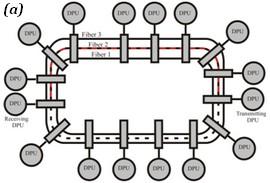Ph.D. Student: Sagi Frishman
Dynamic Optical Circuit Switching (DOCS) is a generic switching concept which addresses the oversubscription problem in packet-based interconnection networks, in particular data centers networks. DOCS exploits the fact that 90% of the data flows inside the data centers is transported in large “elephant” messages. DOCS relieves the oversubscription in the core and aggregation layers of the data center interconnection network by augmenting the latter with an auxiliary network in which direct shortcuts between high-bandwidth demanding network nodes are created on demand, and annihilated at the end of the task. DOCS is implemented by employing wavelength addressing in an auxiliary network which is a WDM operated fiber bundle loop that connects a large number of strategic spots such as “Top of the Rack” switches in the access layer of data centers. A circuit between a pair of nodes in the auxiliary network is created by assigning a fiber-wavelength pair (F-λ).
The transmitting node sends data at λ on F directly to the receiving node which listens exclusively to the data flow on F that is transmitted at λ. The auxiliary network and optional architecture for the DOCS processing unit (DPU) are illustrated schematically in Figures 1a and 1b respectively.
 |
 |
Figure 1: (a) The Auxiliary network with DOCS processing units distributed along the fiber bundle, showing a message transmitted in red on fiber 2 from the transmitting unit to the receiving unit; (b) An optional architecture for the DOCS processing unit.
The DOCS processing units requires for their operation fast wavelength selective switching and wavelength tunability capabilities. These capabilities are not provided by the state of the art photonic engineering. DOCS harnesses Electroholography for providing these functions. This enables wavelength tunability over the entire C band [REF 10], and fast wavelength selective switching [REF 11] and [REF 12]. A set of electroholographic devices and integrated circuits are currently under development . These devices and circuits are implemented in KLTN substrates and are fabricated by employing the refractive index engineering by ion implantations fabrication methodology.
The effect of employing DOCS was put to the test in series of simulations in which the DC interconnection fabric was emulated with and without DOCS, following that, we have shown the performance enhancement of a typical data center interlaced with DOCS.

